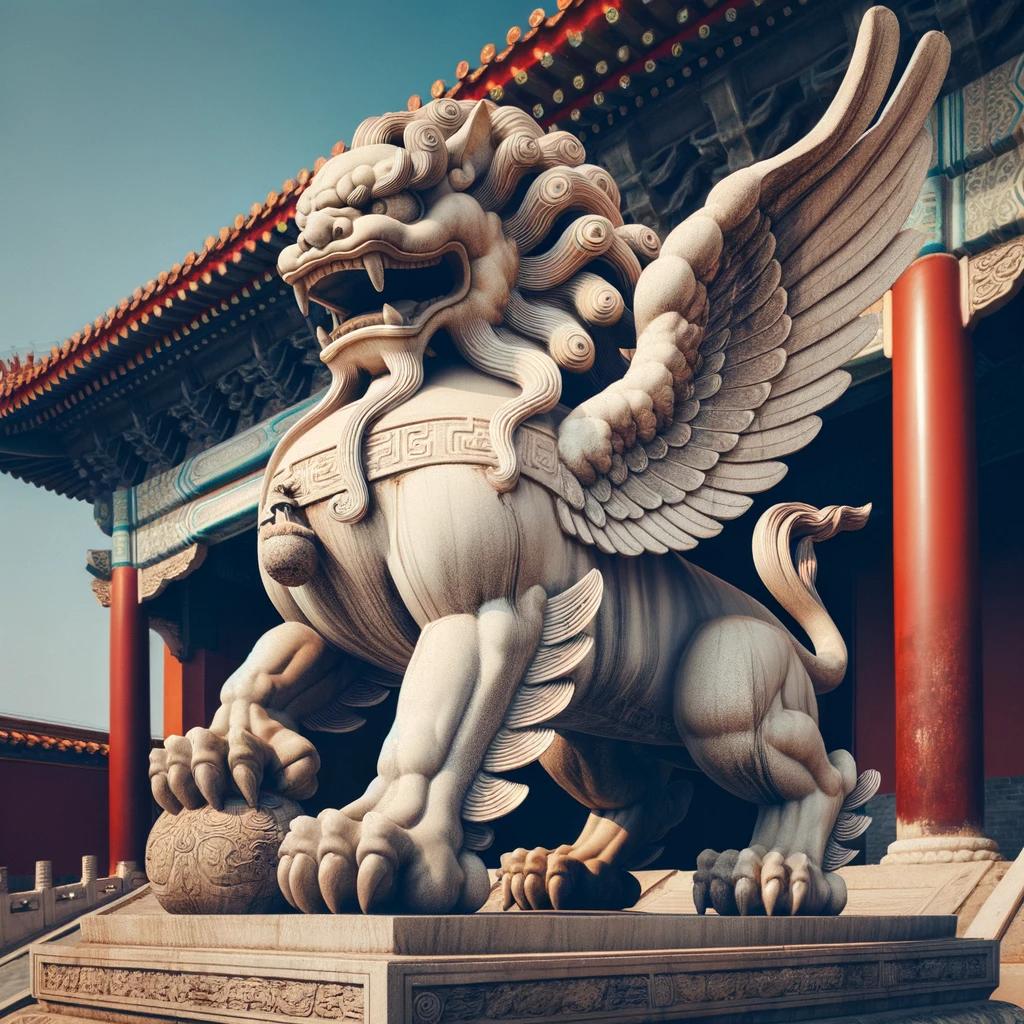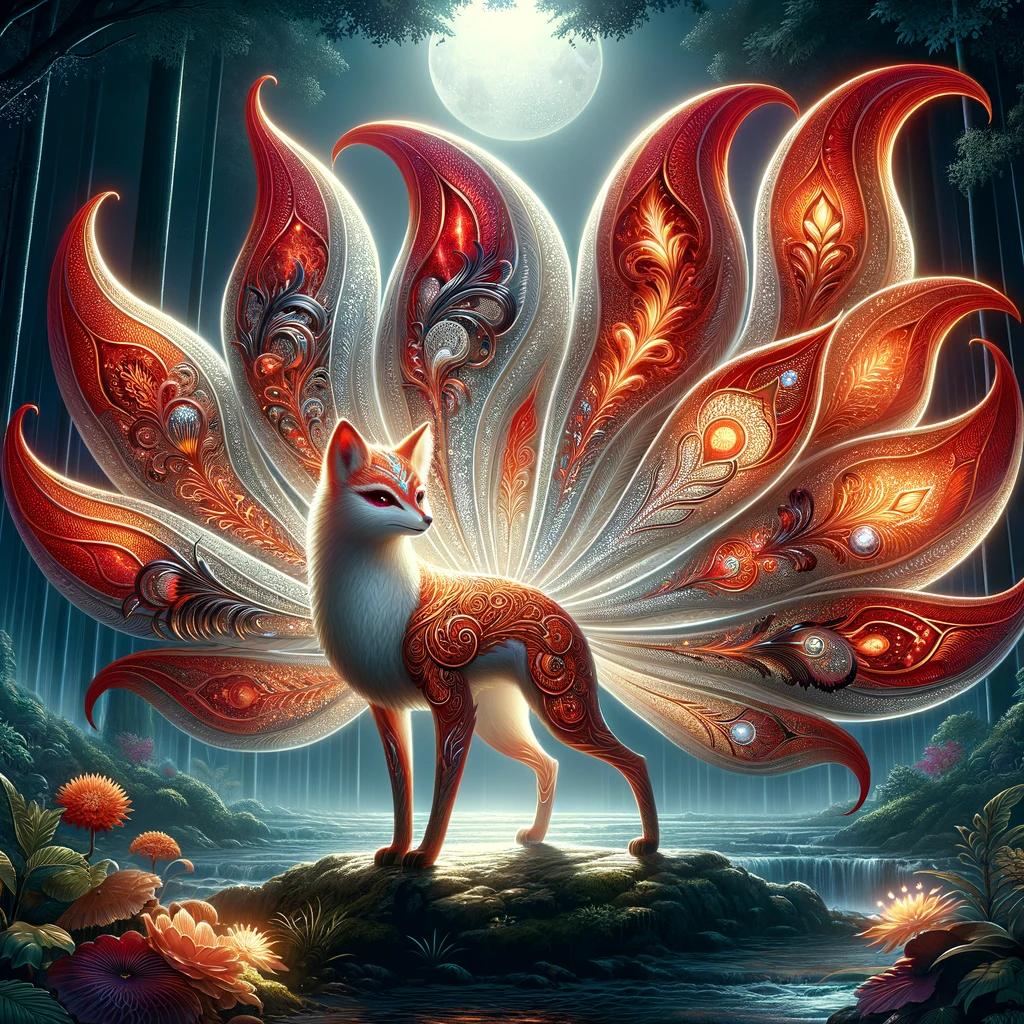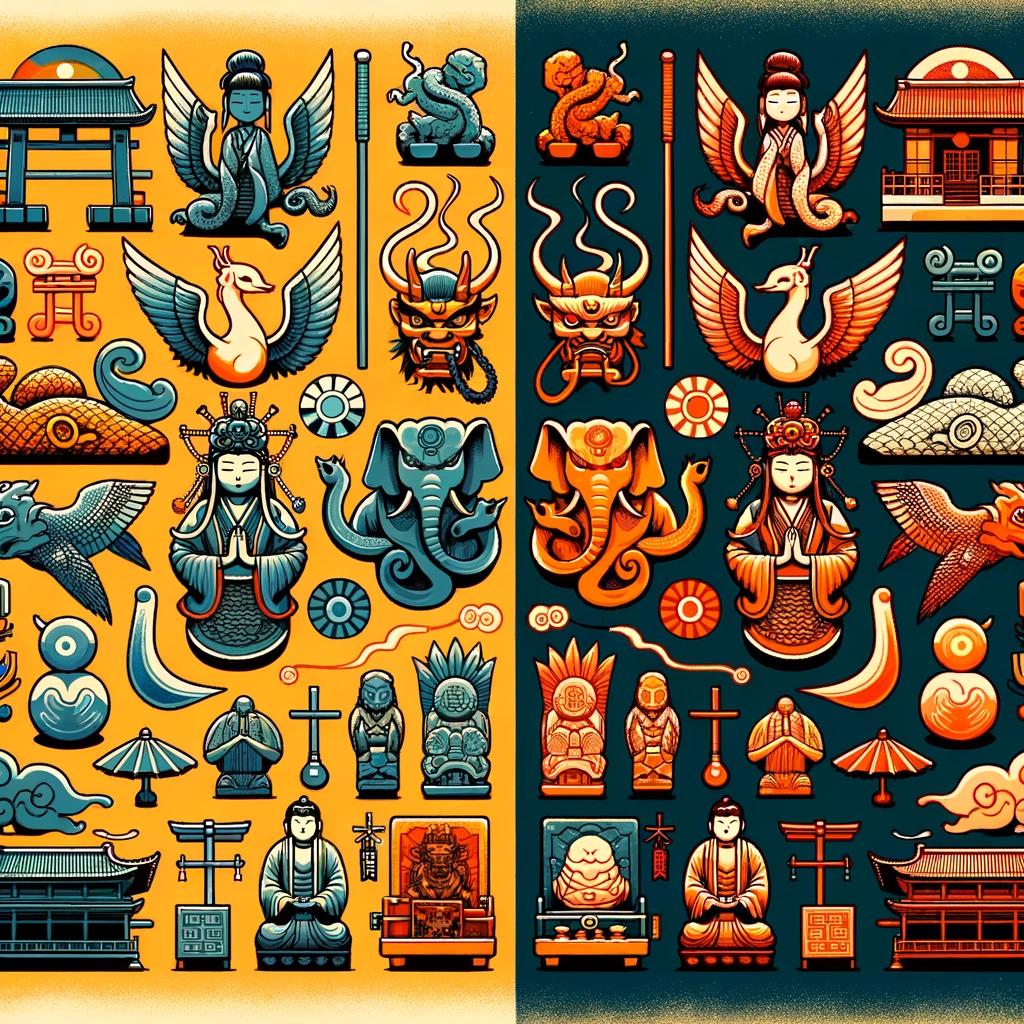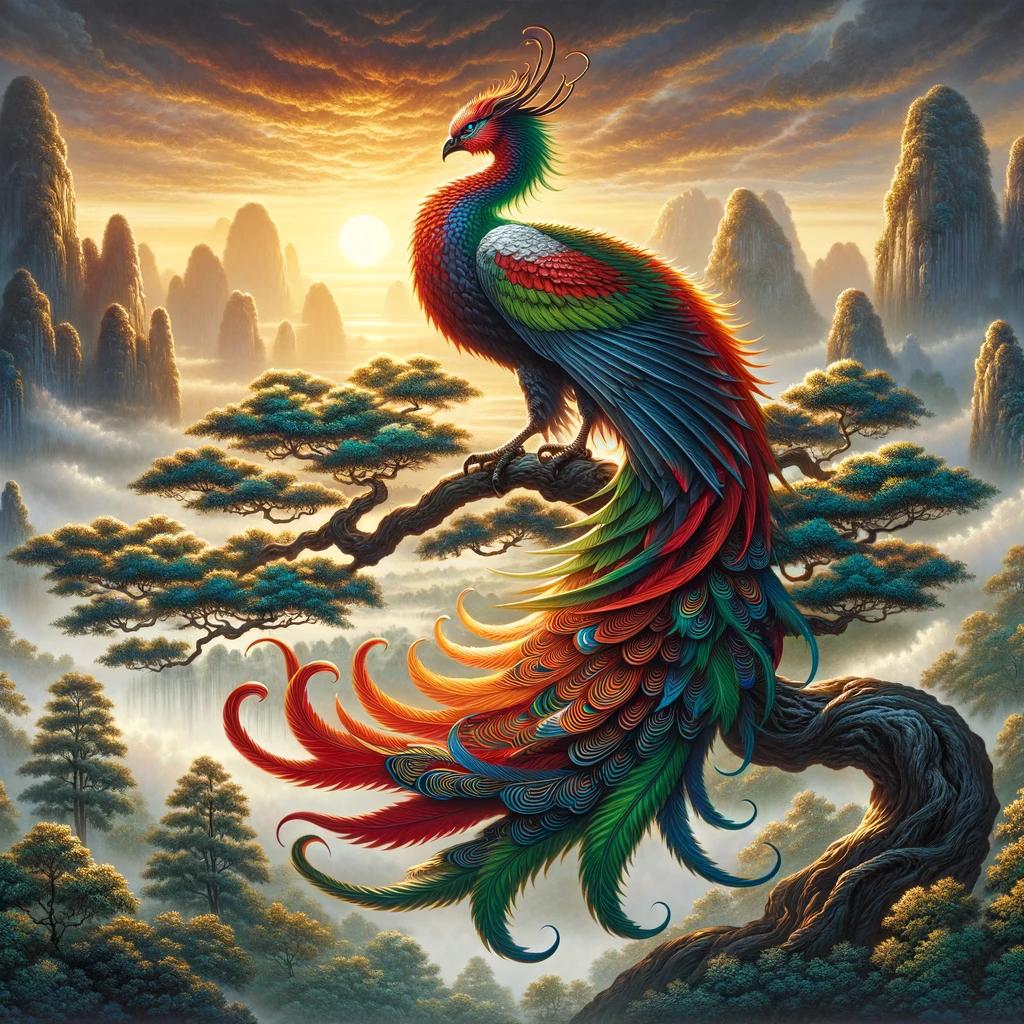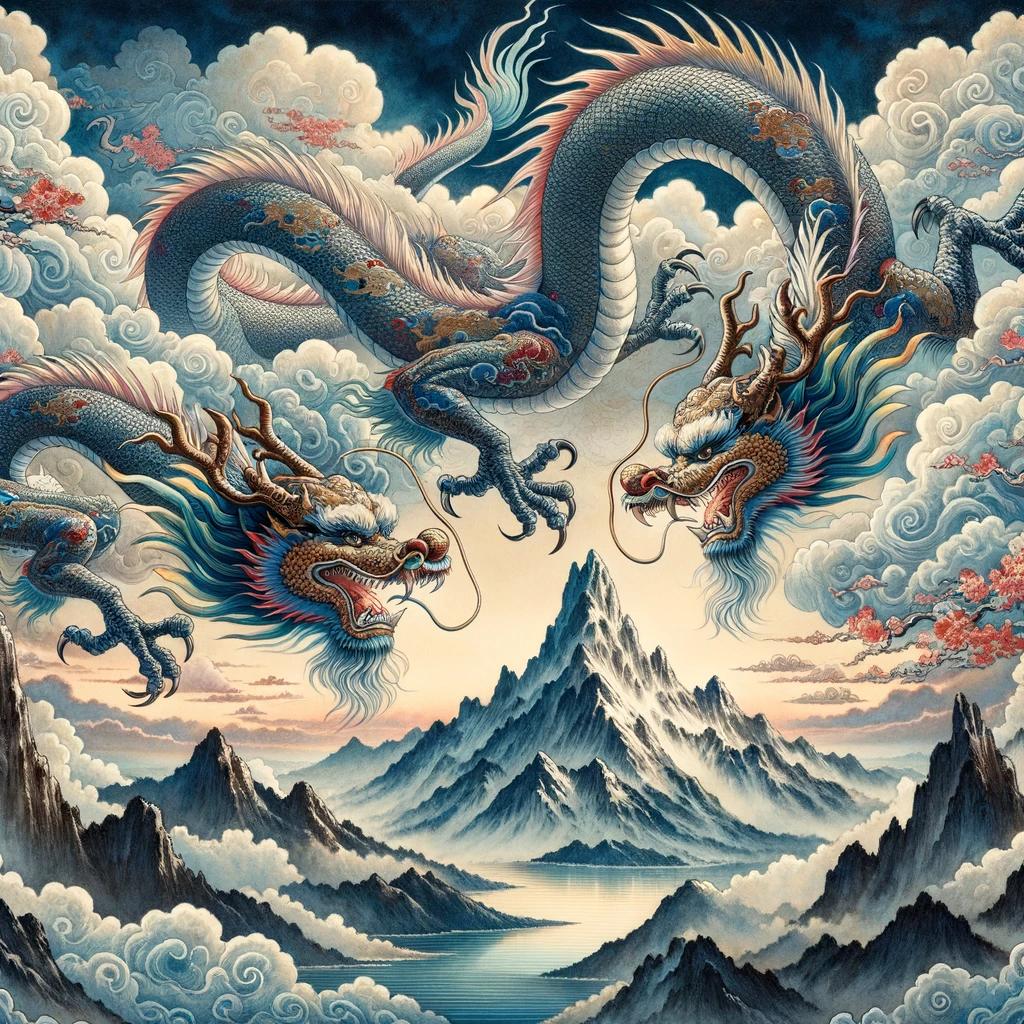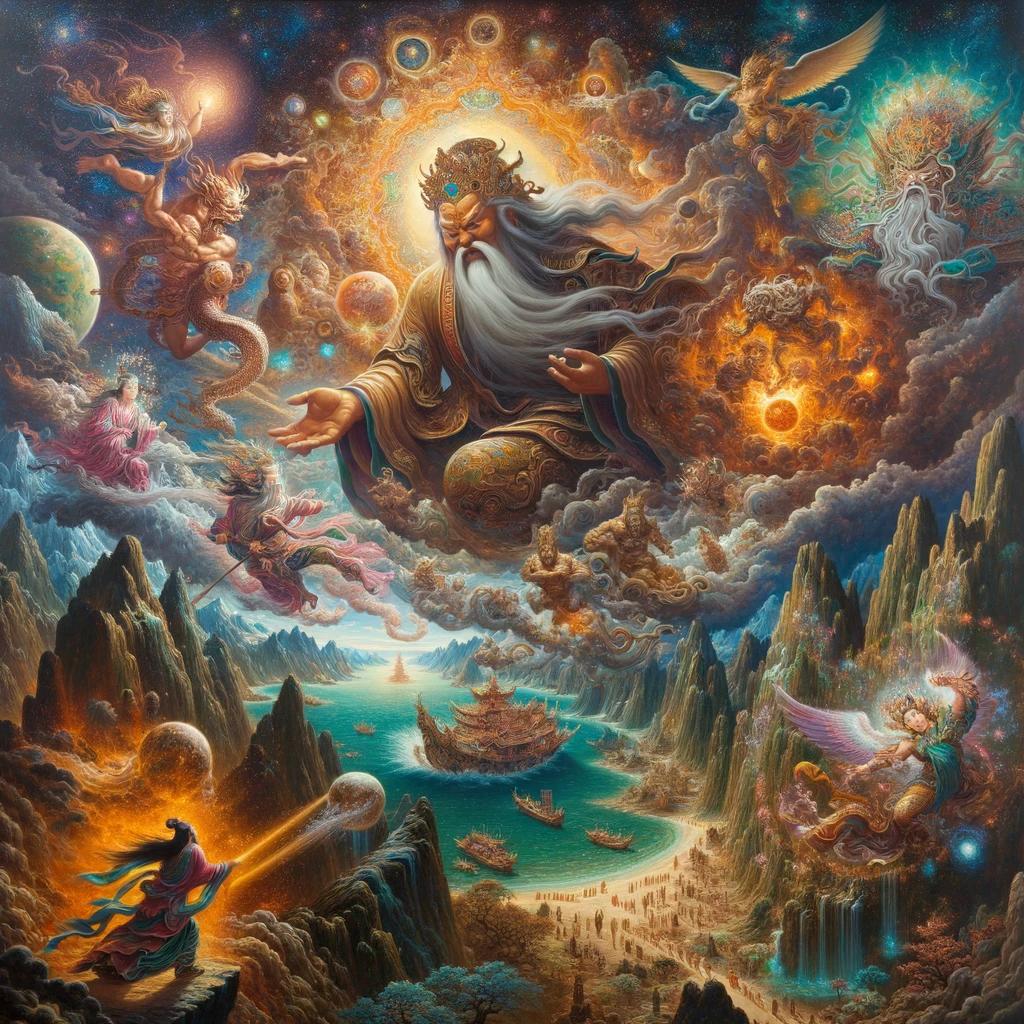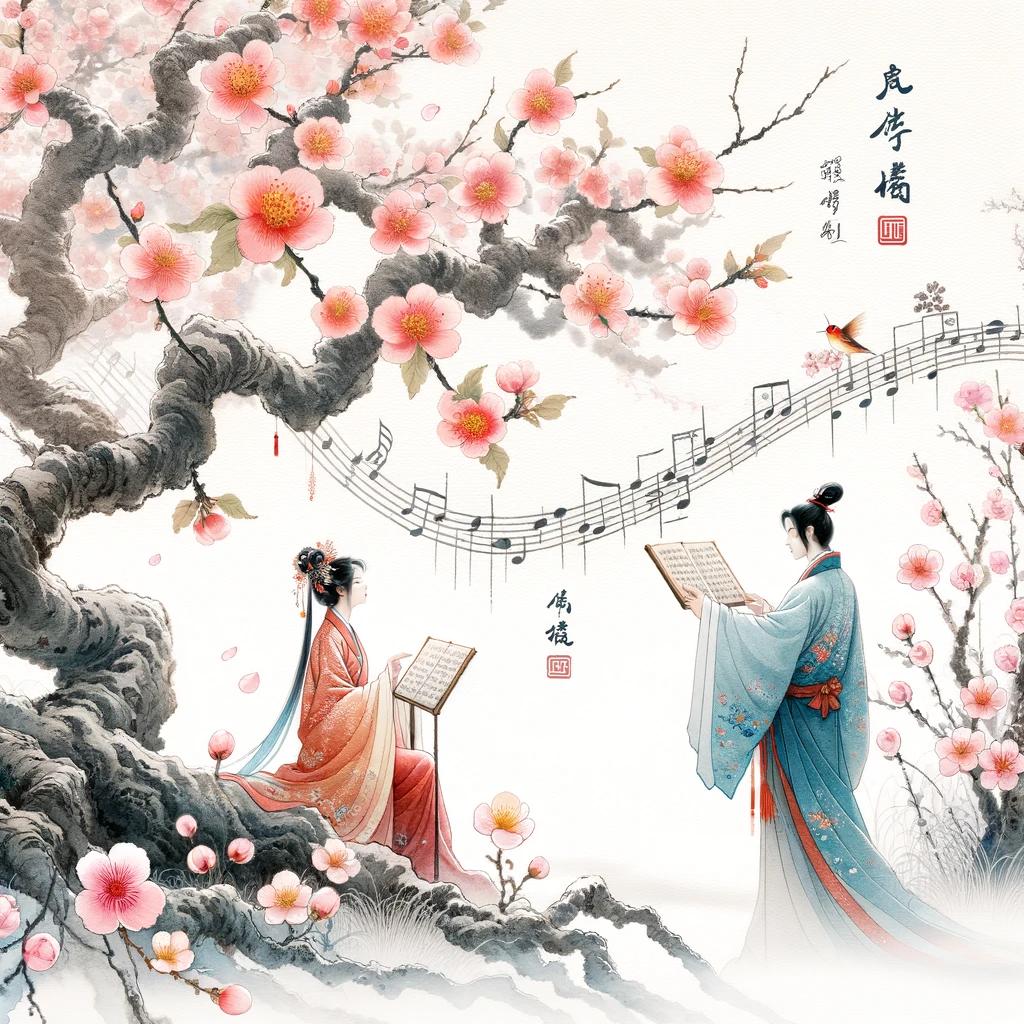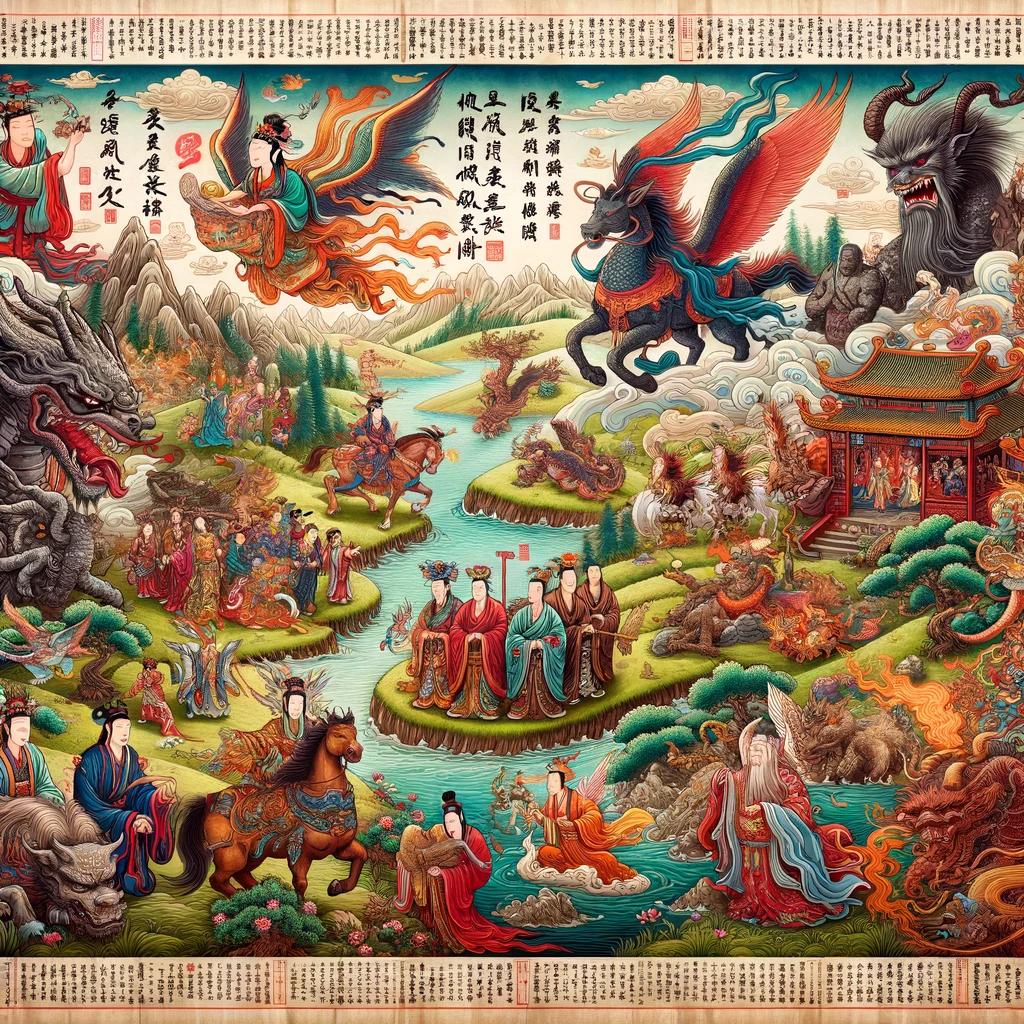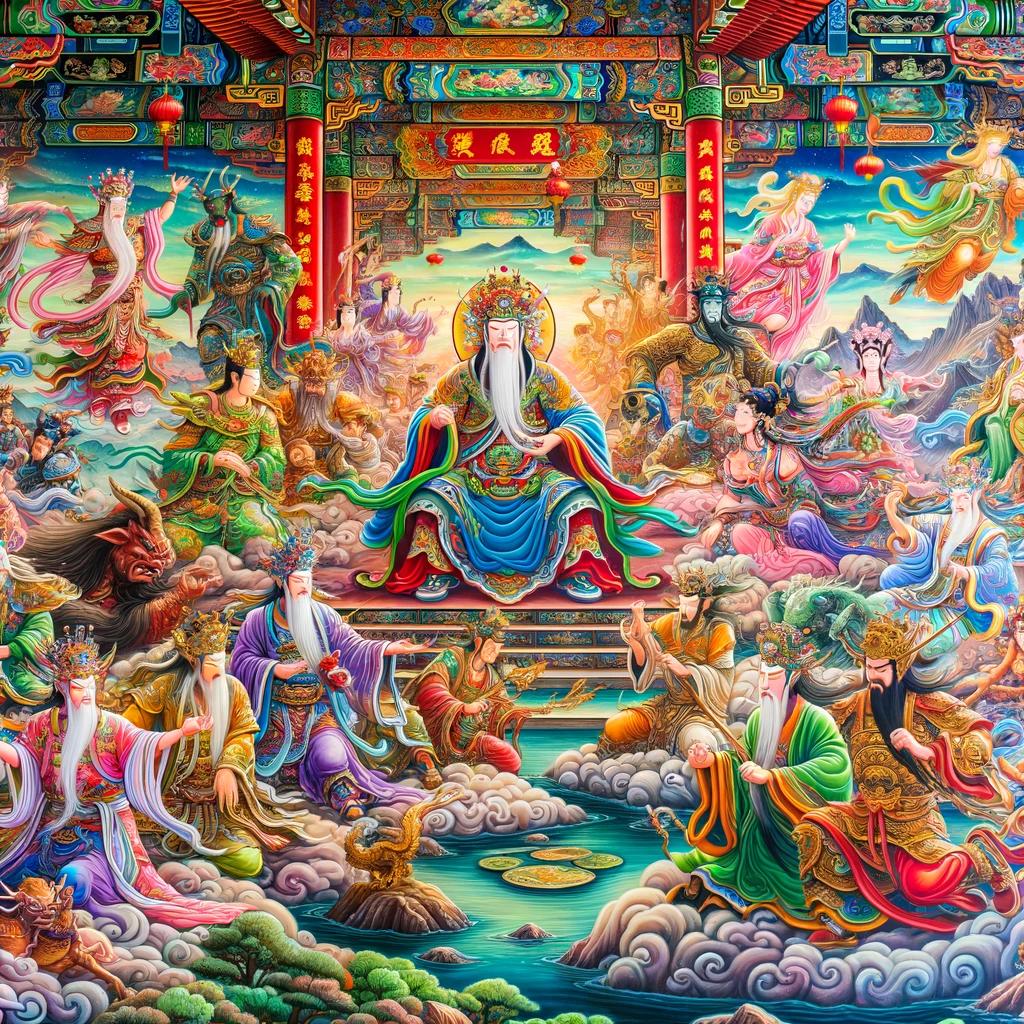Bixie Chinese Mythology
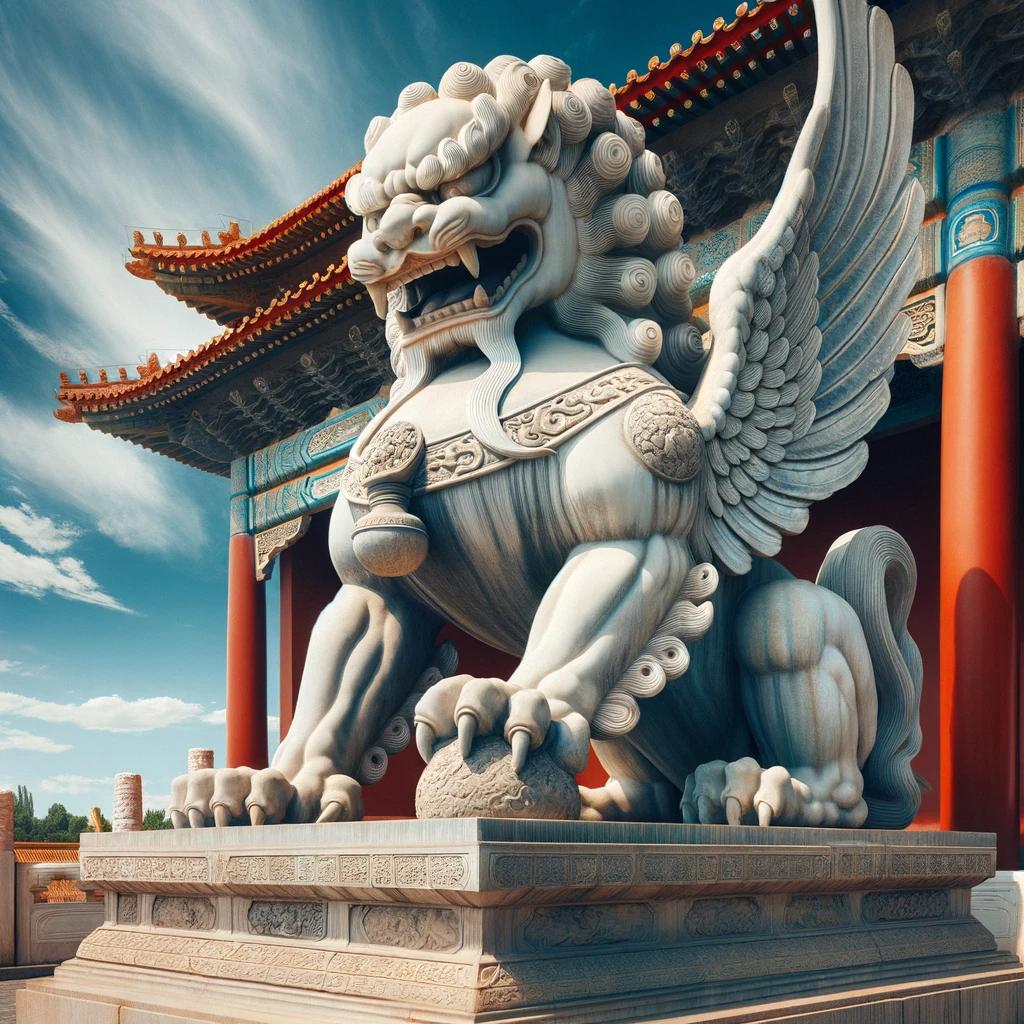
In Chinese mythology, Bixie (also known as Pixiu) is a powerful creature believed to protect the souls of the deceased, practitioners of feng shui, and the xian. It resembles a strong and winged lion, known for its insatiable appetite for gold, silver, and jewels.
Bixie is associated with attracting wealth and is particularly beneficial during challenging zodiac years. With its distinctive horns, the female Bixie wards off evil spirits and aids those facing bad feng shui, while the male Bixie, often depicted with a single horn, is associated with wealth and abundance.
Overview of Bixie Chinese Mythology
In the captivating realm of Chinese mythology, Bixie holds a prominent position as a mythical creature with extraordinary powers. Often referred to as Pixiu, Bixie is a legendary guardian known for its association with wealth, protection, and auspicious energy.
The origins of Bixie can be traced back to ancient times, where it served as a revered symbol of prosperity and good fortune. This celestial creature is depicted as a formidable combination of a strong lion and a majestic dragon, possessing wings that enable it to soar through the heavens.
One of the distinctive attributes of Bixie is its insatiable appetite for gold, silver, and precious jewels. It is believed that this mystical creature possesses the ability to attract abundant wealth and good luck from all directions.
This quality has made Bixie a popular figure in Chinese culture, especially during challenging zodiac years.
There are two variations of Bixie, distinguished by their horns. The female Bixie, known as Bìxié, has the power to repel evil spirits and provide assistance to those afflicted by unfavorable feng shui.
On the other hand, the male Bixie, called Tiānlù, is associated with wealth accumulation and has a remarkable knack for seeking out treasures and riches in the world.
The significance of Bixie in feng shui cannot be overstated.
It is commonly believed that by placing statues or images of Bixie in strategic locations, one can attract prosperity, ward off negative energies, and enhance overall well-being. Its presence in homes, palaces, and important buildings is thought to harmonize and balance the surrounding energy.
In addition to its mystical qualities, Bixie has played a significant role in Chinese history and culture. It has been depicted in various forms of art, including sculptures, paintings, and artifacts, symbolizing the nation’s rich heritage and connection to spirituality.
As you delve deeper into the enchanting world of Bixie Chinese mythology, you will discover the captivating legends, symbolism, and enduring legacy associated with this extraordinary creature. Prepare to be enthralled by the tales of its mythical feats and its lasting influence on Chinese traditions.
The Origins and Legends of Pixiu Creatures
The Pixiu creatures, also known as Bixie, have a rich history and are deeply rooted in Chinese mythology. Legends surrounding their origins offer fascinating insights into their significance within the culture.
According to one myth, Pixiu was originally a powerful celestial beast. It had the head of a Chinese dragon and the body of a lion, combining the fierce qualities of both creatures.
As the story goes, Pixiu violated a law of Heaven by defecating on the Celestial Court grounds and was consequently punished by the Jade Emperor. Its anus was permanently sealed, and its diet was restricted only to gold, silver, and jewels.
Another legend tells of Pixiu as the youngest son of the Dragon King, who was transformed into a creature as a result of breaking a seal. It is said that Pixiu possesses fierce traits and the ability to fend off demons and evil spirits with its sharp fangs.
Furthermore, it is believed to absorb their essence and transform it into wealth, symbolizing the protection and prosperity it brings to its owners.
While the origins of Pixiu are closely tied to mythology, its representation evolved over time.
In ancient Chinese history, Pixiu was depicted with one horn (male) or two horns (female). However, in modern depictions, the single-horned Pixiu is more commonly seen. Its eyes bulge out, and it possesses wings, along with variations that include hooves and a forked tail, symbolizing the containment of wealth within its body.
The unique appearance and mythical qualities of Pixiu have made it distinct from other stone lions or qilin. Its distinguishable feature of feathery wings sets it apart. In ancient times, Pixiu was believed to possess the ability to fly to the realm of immortals, known as xian.
The Pixiu creatures hold a significant place in Chinese culture. They were utilized as symbols on battle flags and standards during the Han dynasty, representing power and military might. Possession of a Pixiu was exclusively reserved for the royal elite during the Qing dynasty, displaying their elevated status.
Through the centuries, Pixiu has remained an important figure in architecture, particularly in warding off negative energy and attracting auspicious energy. Often found adorning the corners of houses, palaces, and important buildings, Pixiu serves as a guardian to the tombs of Han dynasty emperors and aristocrats as well.
As you dive deeper into the enchanting world of Bixie Chinese mythology, the fascinating origins and legends surrounding the Pixiu creatures reveal their esteemed status and enduring cultural significance.
Understanding the Symbolism and Powers of Pixiu
In Chinese mythology, Pixiu holds significant symbolism and possesses mystical powers. This mythical creature is believed to bring wealth and prosperity to its owner. Let’s delve into the various aspects of Pixiu’s symbolism and powers:
Auspicious Symbolism
- Pixiu is considered an auspicious creature that attracts wealth and fortune.
- It symbolizes protection, abundance, and good luck.
- Being a powerful guardian, Pixiu defends against evil spirits and negative energies.
Wealth-Attracting Powers
- Pixiu’s voracious appetite for gold, silver, and jewels is believed to bring monetary gains to its owner.
- It has the ability to attract wealth and prosperity from all directions.
- Many practitioners of feng shui use Pixiu statues or jewelry to invite financial success into their lives.
Guardian of Feng Shui
- Pixiu is an essential component of feng shui practices.
- It is believed to rectify bad feng shui and ward off negative energy.
- Its presence in the home or workplace can harmonize the environment and enhance positive energies.
Mystical Powers
- Pixiu possesses mystical powers associated with attracting wealth, protecting its owner, and aiding spiritual ascension.
- It is believed to transform negative energy into positive energy and facilitate personal growth.
- With its fierce nature, Pixiu can ward off demons, evil spirits, and other malevolent entities.
Understanding the symbolism and powers of Pixiu allows individuals to harness its positive energies and invite financial abundance while enjoying spiritual protection.
Embracing Pixiu in various forms such as statues, jewelry, or artwork can bring an added sense of prosperity and harmony to one’s life.
The Distinction between Bixie and Tiānlù Pixiu
In Chinese mythology, there are two types of Pixiu: Bixie and Tiānlù.
Each of them has its own unique characteristics and roles. Understanding the distinction between the two can provide deeper insights into Chinese folklore and symbolism.
Bixie: The Female Guardian
Bixie, also known as the female Pixiu, is revered for its ability to ward off evil spirits and provide protection against negative energies. It is often depicted with two horns, symbolizing its power and authority.
Bixie is associated with alleviating bad feng shui and bringing harmony and good fortune to its owners.
Tiānlù: The Male Wealth Guardian
On the other hand, Tiānlù, the male Pixiu, is primarily associated with wealth and prosperity. It is often depicted with a single horn, symbolizing its connection to attracting abundance and financial success.
Tiānlù is believed to have the ability to seek out gold and other forms of wealth in the world, guarding and safeguarding it.
While Bixie and Tiānlù may have different roles, they are interconnected.
Bixie serves as the guardian of wealth accumulated by Tiānlù, ensuring that it is safely preserved and protected.
Both Bixie and Tiānlù are mystical creatures with auspicious qualities. They play fundamental roles in Chinese culture, mythology, and feng shui practices, representing power, protection, and prosperity.
Understanding the distinction between these two types of Pixiu can deepen our appreciation for the rich tapestry of Chinese mythology and the symbolism attached to these revered creatures.
Pixiu’s Voracious Appetite for Gold and Wealth
Pixiu, the mythical creature in Chinese mythology, is well-known for its insatiable appetite for gold, silver, and jewels.
This voracious hunger for wealth and riches is believed to be one of its most prominent characteristics. Pixiu is often depicted with an open mouth, ready to devour any precious metals or treasures that come its way.
The association between Pixiu and wealth is deeply rooted in Chinese culture. It is believed that Pixiu has the ability to attract wealth from all directions, ensuring the accumulation of riches for its owners.
This is why statues or figurines of Pixiu are commonly used in Feng Shui practices to enhance prosperity and financial success.
Legend has it that Pixiu was punished by the Jade Emperor for its misconduct and forbidden to consume anything other than gold, silver, and gemstones.
This divine restriction further emphasizes Pixiu’s inclination towards wealth and its unwavering desire to amass riches.
Furthermore, Pixiu is believed to have the unique ability to guard and preserve wealth. It is said that once Pixiu has obtained treasures, it securely stores them in its stomach, allowing its owners to reap the benefits of accumulated wealth.
People often wear Pixiu-inspired jewelry and accessories as a symbol of prosperity and fortune. Pixiu bracelets, in particular, are highly popular as they are believed to bring luck, attract wealth, and provide protection against financial losses.
In essence, Pixiu’s voracious appetite for gold and wealth symbolizes its role as a guardian and magnet for prosperity. Its strong association with wealth and fortune makes it an integral part of Chinese mythology and culture.
Importance of Pixiu in Feng Shui Practices
Pixiu, or Bixie, holds significant importance in the realm of feng shui practices. This mythical creature is believed to possess mystical powers that can attract wealth and abundance from all directions.
Its voracious appetite for gold, silver, and jewels is symbolic of its ability to bring prosperity to its owners.
In feng shui, Pixiu is often used as a powerful Feng Shui cure to attract and protect wealth.
Statues and figurines of Pixiu are commonly placed in homes, offices, and businesses to invite good fortune and ward off negative energy. The creature is said to possess the ability to absorb wealth energy and prevent it from flowing out, serving as a guardian of wealth.
For individuals experiencing a challenging year according to the Chinese zodiac, Pixiu is especially beneficial. It is believed to counteract the negative energies and obstacles associated with the specific zodiac sign, offering protection and support during difficult times.
By harnessing the power of Pixiu, one can enhance their financial luck and overcome obstacles on their path to success.
Furthermore, Pixiu is known for its ability to enhance overall luck and bring harmony into one’s life.
It is believed to repel evil spirits and negative forces, creating a protective shield around its owner. Its presence in a space is said to improve the flow of positive energies, promoting well-being, prosperity, and good fortune.
When incorporating Pixiu in feng shui practices, it is important to understand its proper placement and positioning. The creature is traditionally placed facing the main entrance of a space, symbolizing the attraction of wealth and prosperity into the premises.
It is also common to see Pixiu figurines displayed near cash registers, wallets, or important financial areas to enhance money luck and ensure a steady flow of wealth.
- Attracts wealth and abundance
- Serves as a powerful Feng Shui cure
- Protects against negative energy and evil spirits
- Improves overall luck and well-being
- Enhances the flow of positive energies
In conclusion, Pixiu holds immense significance in the practice of feng shui.
Its mystical powers and association with wealth and protection make it a sought-after creature for those seeking financial prosperity, harmony, and positivity in their lives. By harnessing the energy of Pixiu, individuals can tap into its formidable qualities and invite an abundance of blessings into their surroundings.
Popular Pixiu Jewelry and Accessories, including Pixiu Bracelet
In the realm of Chinese mythology, Pixiu holds a significant place not only as a celestial creature but also as a symbol of abundance and good fortune. It comes as no surprise that Pixiu has become a popular motif for jewelry and accessories, with the Pixiu bracelet being one of the most sought-after items.
The Pixiu bracelet, often made of jade or other precious stones, is believed to possess powerful protective properties and bring wealth to its wearer. It is commonly adorned with intricate carvings representing the characteristics of Pixiu, such as its ferocity and ability to ward off evil spirits.
Wearing a Pixiu bracelet is believed to attract positive energy and ward off negative influences. It is said to promote financial luck, enhance prosperity, and bring opportunities for success. Many individuals, especially those who practice feng shui, consider the Pixiu bracelet as an essential accessory for cultivating abundance and inviting good luck into their lives.
When choosing a Pixiu bracelet, it is important to pay attention to the material and craftsmanship. Authentic jade bracelets, in particular, are highly prized for their beauty and spiritual significance. These bracelets are often crafted with intricate details, showcasing the intricate aura of Pixiu.
Moreover, Pixiu jewelry extends beyond bracelets. Necklaces, earrings, and rings featuring the auspicious creature are also popular choices among those seeking to harness its positive energies. These pieces often incorporate other meaningful symbols or gemstones, further amplifying their significance and desirability.
Whether it’s a Pixiu bracelet or other Pixiu-inspired jewelry, these accessories not only serve as stylish adornments but also carry deep cultural and spiritual meanings. They are treasured keepsakes that connect individuals to the rich tapestry of Chinese mythology and offer a tangible reminder of the potential for prosperity and protection.
As you explore the world of Pixiu jewelry and accessories, immerse yourself in the enchanting realm of Chinese mythology and embrace the powerful energies symbolized by these cherished pieces.
Mythical Traits and Physical Characteristics of Pixiu
Pixiu, the legendary creature from Chinese mythology, possesses fascinating mystical traits and distinct physical characteristics that make it a captivating figure in folklore and culture.
Here, we explore the intriguing aspects that define Pixiu.
Powerful Mystical Abilities
- Pixiu is believed to possess mystical powers that can attract wealth from all directions, making it highly sought after for those facing challenging times in the Chinese zodiac.
- It is considered a powerful protector of the souls of the deceased, practitioners of feng shui, and the xian, bringing comfort and guidance to those under its watchful presence.
Physical Appearance
- Pixiu is a creature with a remarkable fusion of the Chinese dragon’s head and the body of a lion, symbolizing strength, wisdom, and courage.
- Traditionally, Pixiu was depicted with either one horn (male) or two horns (female), but in modern representations, it is more commonly shown with a single horn.
- It is adorned with salient eyes, sharp teeth, and magnificent wings, which give it a majestic and awe-inspiring presence.
- Some variations of Pixiu portray it with hooves and a forked tail, symbolizing the presence of hidden treasures within their stomachs.
Distinguishing Features
- Pixiu can be distinguished from stone lions and qilin by its distinctive feathered wings, which set it apart as a unique and auspicious creature.
- Legend has it that Pixiu possessed the ability to fly to the realm of immortals or xian, further highlighting its mythical nature and connection to celestial beings.
Role in Chinese History and Culture
- Pixiu has played an integral role throughout Chinese history, often associated with the military, representing bravery and protection.
- Its presence can be observed in ancient architecture, adorning the corners of houses, palaces, and significant buildings, warding off negative energy and attracting auspicious chi.
- Notably, Pixiu has been revered as a guardian of imperial tombs, ensuring the protection and prosperity of the emperors.
The mythical traits and physical characteristics of Pixiu continue to capture the imagination and fascination of people today, serving as a symbol of prosperity, protection, and spiritual connection.
Pixiu’s Role in Chinese History and Culture
Pixiu holds a significant place in Chinese history, culture, and mythology. This mythical creature has been revered for centuries and continues to be a symbol of fortune and protection.
Throughout Chinese history, Pixiu has been associated with wealth and prosperity.
It is believed that the creature has the ability to attract wealth from all directions, making it especially popular among businessmen, entrepreneurs, and those seeking financial success.
Not only is Pixiu regarded as a harbinger of wealth, but it also plays a crucial role in protecting individuals from negative energies and evil spirits.
It is believed that Pixiu wards off bad luck and brings good fortune to its owners, making it an essential element in feng shui practices.
In ancient China, Pixiu was often depicted in various forms of artwork, including sculptures, paintings, and carvings.
It was commonly found in important buildings, palaces, and ancestral temples, symbolizing power, courage, and divine protection.
Over time, Pixiu’s imagery and symbolism have evolved while maintaining its reputation as a guardian of wealth.
Today, it continues to be a prominent figure in Chinese culture, often depicted in jewelry, accessories, and other decorative items.
Understanding the significance of Pixiu in Chinese history and culture allows us to appreciate its enduring influence and the role it plays in attracting prosperity and warding off negative energies.
Notable Artifacts and Representations of Pixiu
Throughout history, numerous artifacts and representations of Pixiu have emerged, showcasing the enduring fascination and significance of this mythical creature. These artifacts offer a glimpse into the cultural and artistic interpretations of Pixiu across different periods and regions.
1. Jade Carvings: Jade, a revered material in Chinese culture, has been intricately carved to depict Pixiu. These jade carvings often capture Pixiu’s fierce and energetic presence, emphasizing its role as a guardian of wealth and prosperity.
The translucency of jade adds an ethereal quality to these carvings, enhancing the mystical allure of Pixiu.
2. Ceramic Figurines: Ceramic figurines of Pixiu showcase the craftsmanship and creativity of ancient artisans.
These figurines are meticulously shaped and painted, reflecting the various physical attributes and characteristics associated with Pixiu. They are often displayed in homes and temples, serving as decorative talismans and symbols of good fortune.
3. Paintings and Scrolls: Artists have depicted Pixiu in traditional Chinese paintings and scrolls, capturing its majestic appearance and mythical qualities. These artworks often feature vibrant colors, intricate details, and dynamic brushwork, making Pixiu come to life on the canvas.
The presence of Pixiu in these paintings is believed to bring blessings and ward off misfortune.
4. Sculptures and Statues: Sculptures and statues of Pixiu can be found in temples, palaces, and other significant architectural structures.
These three-dimensional representations showcase Pixiu’s powerful physique, with its dragon-like head, lion body, and wings. These sculptures often adorn the corners of buildings, acting as protective guardians against negative energies.
5.
Jewelry and Accessories: Pixiu-inspired jewelry has become popular, serving as fashionable accessories with symbolic meanings. Pixiu bracelets, in particular, are highly sought after due to their association with wealth attraction and protection.
These bracelets are often made from materials such as jade, obsidian, or other precious gemstones, further enhancing their aesthetic appeal.
As witnessed through these notable artifacts and representations, Pixiu continues to be an enduring figure in Chinese culture.
Its image and symbolism have been passed down through generations, representing wealth, fortune, and protection.
Unraveling the Mystery of Pixiu’s Ancestral Stories
Within the world of Bixie Chinese mythology, the ancestral stories surrounding Pixiu are shrouded in mystery and intrigue. These captivating narratives offer insights into the origins and evolution of this mythical creature, capturing the imagination of believers and scholars alike.
One such tale speaks of Pixiu as the youngest son of the Dragon King, who was transformed into a creature for defying divine decrees. This story not only highlights Pixiu’s tumultuous past but also alludes to its formidable nature and unmatched strength.
Another ancestral story traces Pixiu’s lineage back to the heavens themselves. According to this account, Pixiu ventured into celestial realms, committing a forbidden act that led to its eternal seal. The consequences of its actions manifested in a sealed posterior that became the defining characteristic of the creature.
As the centuries passed, these enchanting ancestral stories became interwoven with the rich tapestry of Chinese folklore. Passed down from generation to generation, they took on new meanings and garnered deeper significance in the cultural and mythological landscape of China.
Today, the unraveling of Pixiu’s ancestral stories serves as a gateway to understanding its role as a mythical guardian and bringer of fortune. These ancient narratives shed light on the creature’s iconic status, giving us a glimpse into its celestial connections and divine origins.
Within the world of collectors and enthusiasts, the study of Pixiu’s ancestral stories adds depth and context to its representation in art, jewelry, and cultural artifacts. Scholars and researchers strive to unlock the symbolism and hidden meanings woven into these tales, bringing us closer to comprehending the essence of Pixiu and its enduring legacy.
By delving into the enigmatic realm of Pixiu’s ancestral stories, we embark on a journey that transcends time and space, immersing ourselves in the wealth of Chinese mythology and the extraordinary world of Bixie.
Exploring the Connection between Pixiu and the Chinese Dragon
The Pixiu, an auspicious creature in Chinese mythology, is often associated with the majestic Chinese dragon. This connection between Pixiu and the dragon holds deep cultural significance and symbolism.
In Chinese folklore, the dragon is revered as a powerful and benevolent celestial being, representing imperial authority, luck, and prosperity.
It is believed to possess extraordinary powers and is often associated with the balance of yin and yang energies.
The inclusion of the Chinese dragon in the context of Pixiu mythology further enhances its mythological essence.
Just as the dragon embodies good fortune and wealth, the Pixiu is known for its ability to attract riches and protect against misfortune. Together, they symbolize the perfect harmony between wealth, power, and protection.
Furthermore, the dragon’s association with the Pixiu helps to reinforce the Pixiu’s formidable nature. It adds an element of mystique and symbolism to the already powerful creature, elevating its status in Chinese mythology.
Both the Chinese dragon and Pixiu are creatures of immense cultural importance, and their embodiment in mythology intertwines their significance. Exploring the connection between Pixiu and the Chinese dragon reveals the depth of Chinese mythology and the intricate symbolism embedded within its folklore.
By recognizing the ancient bond between these two mythical creatures, one can gain a deeper understanding of their significance in Chinese culture and the beliefs associated with them. This exploration sheds light on the underlying narratives and metaphysical aspects that continue to captivate and inspire people to this day.
Pronunciation and Phonetics of “Pixiu”
When it comes to the pronunciation of ‘Pixiu,’ it may seem a bit tricky at first. But fear not, we’ve got you covered! Let’s break it down and ensure you can pronounce this fascinating creature’s name with confidence.
The word ‘Pixiu’ is pronounced as “pee-shoo.” The ‘Pi’ sounds like the word “pee,” and the ‘xiu’ sounds like the word “shoo.” When saying it aloud, emphasize the first syllable and slightly soften the ending.
Now, let’s dive into the phonetics of ‘Pixiu’ to understand the pronunciation in more detail:
- The letter ‘P’: Pronounce it as in the word “pee.” It is a voiceless bilabial plosive, meaning you use both lips to produce the sound.
- The letters ‘i’ and ‘xi’: These correspond to the vowel sound in the word “bee.”
It is a high-front tense vowel.
- The letters ‘u’: Pronounce it as in the word “shoe.” It is a high-back tense vowel.
Put these sounds together, and you’ll be confidently pronouncing ‘Pixiu’ in no time!
This pronunciation guide will help you effectively communicate and discuss this powerful entity in Chinese mythology.
The Legacy of Pixiu in Ancient Dynasties
The ancient dynasties of China hold a rich heritage of mythology and folklore, with Pixiu being an integral part of this cultural legacy. Throughout history, the presence and significance of Pixiu have been deeply intertwined with the ruling dynasties of the time, leaving behind an enduring legacy that continues to captivate us today.
During the Han dynasty, Pixiu made its initial appearance and quickly became synonymous with the military forces of ancient China. These majestic creatures were revered and symbolically used in battle, adorning flags and banners as symbols of strength and protection.
In the subsequent Qing dynasty, the ownership of Pixiu became a privilege reserved for the royal elite. Commoners were strictly prohibited from possessing these sacred creatures, further elevating their status and mystique.
This exclusivity heightened their desirability, cementing Pixiu’s association with prosperity, luck, and imperial power.
In architectural design, Pixiu found its place as a guardian against negative energies and a bringer of auspicious vibes.
Their presence was often depicted on the corners of roofs, safeguarding homes, palaces, and important buildings from malevolent forces. Additionally, Pixiu statues were placed as protectors of royal tombs, ensuring the eternal well-being of emperors and nobility.
Today, remnants of Pixiu’s legacy can still be observed in ancient artifacts and representations. Exquisite jade carvings and sculptures exhibit the craftsmanship and reverence bestowed upon Pixiu throughout the ages. These artifacts serve as a tangible link to the past, allowing us to delve deeper into the cultural and mythological significance of these mystical creatures.
Nanjing Museum offers a captivating experience for those seeking a deeper understanding of Pixiu’s influence. The museum showcases a diverse collection of historical artifacts, including intricately detailed Pixiu sculptures. Exploring these exhibitions allows visitors to appreciate the artistic and spiritual connection that Pixiu held within ancient dynasties.
As we uncover the legacy of Pixiu in these ancient dynasties, we gain insight into the enduring power and mystique that surrounds these mythical creatures. Their role as protectors, symbols of wealth, and bearers of luck has left an indelible mark on Chinese culture and mythology, transcending time and captivating us with their enigmatic allure.
Experience Pixiu’s Influence at the Nanjing Museum
The Nanjing Museum offers a captivating experience to explore the profound influence of Pixiu in Chinese mythology. As you enter the museum, you’ll be immersed in a world where ancient legends come to life.
Discover the mesmerizing artifacts and representations of this mythical creature that have been carefully preserved throughout history.
As you wander through the exhibits, you’ll encounter intricately designed statues and sculptures depicting Pixiu in various forms.
Marvel at the exquisite craftsmanship and attention to detail that brings these mystical creatures to life. Each piece tells a story, conveying the power and significance of Pixiu in Chinese culture.
The Nanjing Museum showcases the rich legacy of Pixiu through a diverse collection of ancient artifacts. Admire the symbolic meanings behind Pixiu’s physical features, such as its wings, horns, and fierce expression.
Gain a deeper understanding of how Pixiu is intertwined with the Chinese Dragon, another iconic creature in Chinese mythology.
As you explore the museum’s displays, you’ll gain insights into the role of Pixiu as a protector against evil spirits.
Discover how these mythical creatures were believed to safeguard tombs and bring fortune to their owners. Marvel at the tales of Pixiu-protected tombs and the belief in their ability to ensure the prosperity and well-being of the deceased.
At the Nanjing Museum, you’ll also uncover the connections between Pixiu and other mythical creatures such as Qilin and Fenghuang. Delve into the overlapping symbolism and significance of these mystical beings to gain a comprehensive understanding of Chinese mythology.
Don’t miss the opportunity to witness the evolution of Pixiu’s image in contemporary culture. Explore how this ancient creature continues to inspire artists and designers, leaving its mark on various aspects of modern society.
From fashion accessories to home décor, Pixiu’s influence is still prevalent, symbolizing good fortune and prosperity in today’s world.
Visiting the Nanjing Museum provides a remarkable journey through time, where you can immerse yourself in the captivating influence of Pixiu.
Gain a deeper appreciation for Chinese mythology and the profound significance this mythical creature holds in Chinese culture. Whether you’re a mythology enthusiast or simply curious about ancient legends, the Nanjing Museum offers an unforgettable experience that sheds light on the enigmatic world of Pixiu.
Unveiling the Enigmatic Bixi Dragon in Chinese Mythology
Deep within the realms of Chinese mythology lies the enigmatic creature known as the Bixi Dragon. This mystical creature, with its origins deeply rooted in ancient legends, captivates the imagination with its unique characteristics and rich symbolism.
The Bixi Dragon, also known as Bixi Long or Bixi Qilong, is a powerful and revered creature in Chinese folklore. It is often depicted as a dragon with a turtle-like shell on its back, symbolizing its connection to both land and water.
Its majestic presence and mythical allure make it a subject of fascination and intrigue.
According to ancient tales, the Bixi Dragon is regarded as one of the most auspicious and benevolent beings in Chinese mythology.
It represents wisdom, protection, and strength, embodying the harmonious balance between heaven and earth. The Bixi Dragon is said to guard important architectural structures, such as bridges, palaces, and tombs, acting as a guardian and protector of all that is sacred.
One of the most intriguing aspects of the Bixi Dragon is its association with imperial insignia. In ancient China, stone statues of Bixi dragons were often placed as decorative ornaments, embellishing the tombs of emperors and members of the royal family.
These elaborate sculptures stood as a testament to the imperial power and served as a symbol of divine authority.
The Bixi Dragon’s significance goes beyond its physical representation. It is believed to possess supernatural abilities and spiritual qualities.
Legends speak of its ability to communicate with the divine and provide guidance and wisdom to those who seek it. Its presence brings forth positive energy and ushers in good fortune and prosperity.
Throughout history, the Bixi Dragon has become an enduring cultural symbol, reflecting the deep-rooted reverence for dragons and turtles in Chinese tradition. Its image can be seen in various art forms, from ancient sculptures to modern paintings, showcasing its timeless allure and impact on Chinese art and aesthetics.
As we delve deeper into the realm of Bixi Chinese mythology, we unravel the enigmatic Bixi Dragon’s significance in shaping the belief systems, art, and cultural traditions of ancient China.
Through its rich symbolism and captivating legends, the Bixi Dragon continues to inspire and fascinate, leaving a profound imprint on Chinese culture and mythology for generations to come.
Understanding the Jade Emperor’s Influence on Pixiu
The Jade Emperor, known as Yu Huang Shangdi in Chinese mythology, holds significant influence over Pixiu creatures.
According to legends, the Jade Emperor is the supreme deity and ruler of heaven, overseeing the celestial realm and mortal world. It is believed that the Jade Emperor bestowed upon Pixiu creatures their mystical powers and abilities.
As an auspicious creature, Pixiu holds a special connection to the Jade Emperor. It is said that Pixiu acts as a divine messenger between the mortal realm and heaven, carrying the prayers and wishes of individuals to the Jade Emperor.
This sacred role highlights the reverence and respect bestowed upon Pixiu in ancient Chinese culture.
The influence of the Jade Emperor on Pixiu extends beyond their spiritual connection. The Jade Emperor is also associated with good fortune, prosperity, and divine protection.
It is believed that Pixiu’s powers of attracting wealth and safeguarding against evil spirits are enhanced by the blessings and favor of the Jade Emperor.
In traditional ceremonies and rituals, offerings are made to the Jade Emperor to seek his blessings and guidance.
These offerings often include food, incense, and other symbolic items. Pixiu is often depicted alongside the Jade Emperor in artwork and religious sculptures, representing their intertwined existence and the harmony between heaven and earth.
Understanding the Jade Emperor’s influence on Pixiu provides insight into the multifaceted beliefs and cultural significance surrounding these mythical creatures. It symbolizes the deep-rooted spirituality and the profound connection between humans and the divine in Chinese mythology.
Pixiu’s Role in Safeguarding against Evil Spirits
In Chinese mythology, Pixiu plays a significant role in safeguarding against evil spirits. This mystical creature is believed to possess powerful energy and the ability to ward off malevolent forces.
Its fierce nature and large fangs make it a formidable protector against demons and other malicious entities.
According to ancient tales, Pixiu has the unique capability to drain the essence of evil spirits and transform it into wealth and prosperity.
It acts as a spiritual shield, shielding its owners from any harm or misfortune caused by negative energies.
Many people use statues or figurines of Pixiu in their homes or office spaces to create a protective barrier against evil spirits.
These symbolic representations serve as a reminder of the creature’s mythical powers and its ability to ward off negativity.
Furthermore, Pixiu is often associated with wealth, luck, and financial abundance. It is believed that by possessing or keeping a Pixiu close to oneself, individuals can attract good fortune and ward off any negative influences that may hinder their financial success.
In traditional Feng Shui practices, placing a Pixiu statue in certain areas of the home is believed to promote positive energy, dispel evil forces, and attract wealth. It is customary to position the figurine facing the main entrance, as this is said to ensure that wealth and prosperity enter the premises.
It is important to note that Pixiu’s role in safeguarding against evil spirits is rooted in Chinese folklore and mythology. While many believe in its mystical powers, it is always necessary to approach such beliefs with an open mind and respect for cultural traditions.
Mythical Connections: Qilin, Fenghuang, and Pixiu
In the realm of Chinese mythology, there exists a fascinating interconnection between three mythical creatures: Qilin, Fenghuang, and Pixiu. These creatures, each with their own distinctive characteristics, play significant roles in the folklore and cultural beliefs of ancient China.
Qilin, also known as the Chinese unicorn, is a celestial creature believed to bring good fortune and prosperity. It is often depicted with the body of a deer, the tail of an ox, hooves like a horse, and scales covering its body.
Qilin represents benevolence, righteousness, and wisdom, and is considered a symbol of peace and harmony.
Fenghuang, or the Chinese phoenix, is a magnificent bird associated with rebirth, renewal, and immortality.
It possesses the head of a golden pheasant, the body of a mandarin duck, the tail of a peacock, and the wings of a swallow. Fenghuang represents the virtues of virtue, grace, and beauty, and is regarded as a symbol of power and prosperity.
And then there’s Pixiu, the powerful creature we have delved into extensively. With its resemblance to a strong, winged lion, Pixiu holds a special place in Chinese mythology as a guardian of wealth and prosperity.
Known for its voracious appetite for gold, silver, and jewels, Pixiu is believed to possess mystical powers that can attract wealth from all directions. Its association with good fortune and protection against evil spirits complements the symbolism of Qilin and Fenghuang.
These three mythical creatures, Qilin, Fenghuang, and Pixiu, are often interconnected in ancient Chinese beliefs and symbolism.
They represent a trinity of auspiciousness, with each creature embodying different aspects of fortune, power, and protection. Together, they symbolize a harmonious and prosperous existence, with their combined energies bringing forth blessings and positivity.
Exploring the mythical connections between Qilin, Fenghuang, and Pixiu reveals a rich tapestry of symbolism and cultural significance deeply rooted in Chinese mythology and folklore. Their stories and presence continue to captivate the imagination, reminding us of the enduring allure and power of mythical creatures in shaping our beliefs and traditions.
The Symbolic Meaning of Pixiu’s Four Wings
In the realm of Chinese mythology and folklore, the Pixiu creature is renowned for its distinctive feature – four wings. These wings symbolize various aspects and hold significant meaning in relation to Pixiu’s powers and characteristics.
1. Abundance and Prosperity: The first wing represents wealth and abundance. It is believed that Pixiu’s wings have the ability to attract and accumulate riches from all directions, ensuring prosperity for its owner.
2. Protection and Security: The second wing symbolizes protection and security. It is said that Pixiu’s wings possess a protective shield that shields its owner from negative energies, evil spirits, and misfortunes, ensuring a safe and secure environment.
3. Spiritual Transformation: The third wing signifies spiritual transformation. As Pixiu is considered a spiritual creature, its wings represent the connection between the earthly realm and the celestial realm, facilitating spiritual growth and enlightenment.
4. Balance and Harmony: The fourth wing represents balance and harmony. Pixiu’s wings help restore equilibrium and maintain a harmonious energy flow in the environment, promoting a sense of balance and serenity.
The four wings of Pixiu combine to create a harmonious and powerful force that brings forth prosperity, protection, spiritual growth, and overall balance. They are an embodiment of its auspicious nature and serve as a visual reminder of the creature’s divine attributes.
Intriguing Tales of Pixiu-Protected Tombs
Throughout ancient Chinese history, Pixiu-protected tombs have captivated the imagination with their mysterious tales. These tombs, adorned with extensive artwork and intricate carvings, were believed to be the final resting places of esteemed individuals, including emperors and nobles.
The presence of Pixiu in these burial sites added an extra layer of protection and ensured the prosperity of the deceased in the afterlife.
One fascinating tale tells of the tomb of Emperor Wu of Han, located in the ancient capital of Chang’an.
Guarded by stone Pixiu statues at the entrance, the tomb is said to house a hidden treasure trove of precious artifacts and wealth. Many adventurers and archaeologists have sought to uncover this tomb’s secrets, but it remains elusive, shrouded in mystery and protected by the watchful gaze of the Pixiu guardians.
Another intriguing story surrounds the tomb of Empress Dowager Cixi in the Western Qing Tombs. The tomb complex is renowned for its architectural grandeur and the presence of Pixiu statues throughout.
Legend has it that anyone who disturbs the tomb’s sanctity will be met with misfortune and calamity. This eerie reputation has deterred many from venturing into its depths, leaving the secrets of the Pixiu-protected tomb undisturbed.
In the ancient city of Xi’an, the mausoleum of Qin Shi Huang, the first emperor of China, is a testament to the grandeur and majesty of Pixiu-protected tombs. The site is guarded by an army of terracotta warriors and the mythical creatures themselves.
It is believed that these guardians were placed to protect the emperor’s remains and to ward off any ill fortune that might befall the site.
- Many Pixiu-protected tombs are adorned with intricate murals depicting the mythical creatures in action.
These stunning artworks tell stories of valor, protection, and the eternal power of the Pixiu.
- Explorers and archaeologists continue to uncover new Pixiu-protected tombs, each with its unique history and secrets waiting to be revealed.
- The presence of Pixiu in these tombs highlights their significance in Chinese culture and their role in ensuring the welfare and prosperity of the deceased.
As we marvel at the tales of Pixiu-protected tombs, we are reminded of the ancient Chinese beliefs that revered these legendary creatures as protectors and bestowers of fortune.
These captivating stories serve as a testament to the enduring fascination and importance of Pixiu in Chinese mythology and history.
Pixiu as a Cultural Icon: Los Angeles County Museum Experience
Visiting the Los Angeles County Museum is an incredible opportunity to explore the rich cultural significance of Pixiu in Chinese mythology.
As a powerful symbol of wealth, protection, and fortune, Pixiu has captivated the imagination of people for centuries. Stepping into the museum, you’ll be immersed in a world where ancient legends come to life through meticulously curated artifacts and captivating displays.
Walking through the halls, you’ll encounter a diverse collection of Pixiu sculptures, jade carvings, and intricate artworks that showcase the enduring allure of this mythical creature. Each piece tells a story, tracing the lineage of Pixiu’s influence across different dynasties and regions of China.
The exhibition highlights the evolution of Pixiu’s representation, ranging from the more traditional depictions with wings and singular or double horns to modern interpretations that fuse classical elements with contemporary aesthetics.
The exhibition also sheds light on the connections between Pixiu and other mythical creatures like the Qilin and Fenghuang, further emphasizing the intricate web of mythology and symbolism in Chinese culture.
Pixiu’s Role in Safeguarding against Evil Spirits
One fascinating aspect of Pixiu’s cultural significance is its role as a guardian against evil spirits and negative energies. According to ancient beliefs, Pixiu possesses the ability to repel malevolent forces and bring good fortune to its owner.
As you explore the exhibition, you’ll learn about the rituals and practices associated with Pixiu’s protection, ranging from statues placed at entrances to households to amulets and jewelry adorned with its likeness.
The exhibition also delves into the mythical stories that surround Pixiu’s supernatural abilities. Legends speak of Pixiu’s fierce nature, its ability to attack demons with its formidable fangs, and its capability to transform their essence into wealth.
It’s a reminder of the enduring belief in the power of Pixiu to not only safeguard individuals but also to elevate them to new heights.
Exploring the Jade Emperor’s Influence on Pixiu
Central to the exhibition is the exploration of the Jade Emperor’s influence on Pixiu.
Known as a high-ranking deity in Chinese mythology, the Jade Emperor is associated with heavenly realms and divine authority. The exhibition uncovers the intricate relationship between Pixiu and the Jade Emperor, showcasing how the creature’s connection to wealth and prosperity is intertwined with celestial powers.
The artifacts on display, including intricately carved jade figurines and ceremonial objects, offer a glimpse into the reverence and respect bestowed upon Pixiu as an intermediary between mortals and the divine.
It’s a fascinating journey into the spiritual realms and the divine intervention believed to be at work in the realm of wealth and fortune.
Pixiu’s Enduring Legacy
The Los Angeles County Museum exhibition on Pixiu emphasizes the creature’s lasting impact and its continued relevance in contemporary culture. Despite originating centuries ago, Pixiu maintains its allure and continues to be an inspirational symbol for those seeking prosperity, protection, and enlightenment.
As you leave the exhibition, you’ll carry with you not only a deeper understanding of Pixiu’s cultural significance but also a newfound appreciation for the timeless myths and legends woven into the fabric of Chinese heritage.
Pixiu’s Evolving Image in Contemporary Culture
In modern times, Pixiu has experienced a significant transformation in its image and representation within contemporary culture. The mythical creature has become a popular symbol and has found its way into various aspects of everyday life.
One notable aspect of Pixiu’s evolving image is its growing popularity in the world of fashion and jewelry. Pixiu-themed accessories, such as bracelets and pendants, have gained immense popularity among those seeking to embrace the creature’s auspicious qualities.
These stylish adornments are believed to attract wealth and bring good luck to the wearer.
Beyond fashion, Pixiu’s presence can also be seen in various forms of contemporary artwork. Many artists, both Chinese and international, have been inspired by the creature’s rich mythology and incorporate its likeness into their creations.
Paintings, sculptures, and mixed media artworks often depict Pixiu as a symbol of prosperity and spiritual protection.
In the entertainment industry, Pixiu’s popularity has found its way into movies, television shows, and even video games.
The creature’s powerful and mystical attributes make it a fascinating subject for storytelling and visual representation. Its inclusion in popular culture speaks to its enduring appeal and the ongoing fascination with Chinese mythology.
Furthermore, Pixiu’s positive symbolism and association with wealth have made it a common motif in business and commercial settings. Many companies and organizations prominently display statues or artwork of Pixiu to attract prosperity and success.
It has become a visual reminder of abundance and financial growth in office spaces, retail establishments, and financial institutions.
Lastly, Pixiu’s influence extends to the realm of spirituality and metaphysics. It is often incorporated into spiritual practices such as feng shui and meditation.
People utilize Pixiu’s image as a manifestation of their desires for wealth, abundance, and protection. The creature’s representation serves as a reminder to focus on positive energy and align oneself with prosperity.
As Pixiu’s image continues to evolve and adapt to modern culture, its significance remains deeply rooted in Chinese mythology. Its enduring appeal and relevance speak to its timeless portrayal as a symbol of wealth, protection, and spiritual abundance.
.











